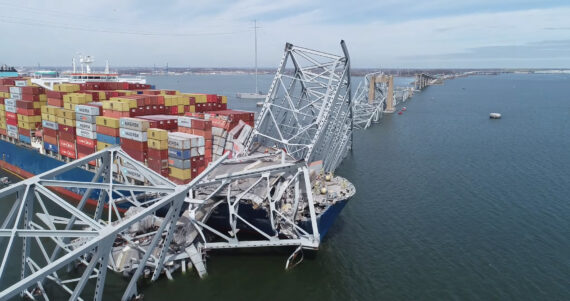by WorldTribune Staff, March 31, 2024
It may take years to reopen the Baltimore port following the collapse of the Francis Scott key Bridge.
“Tens of thousands of jobs are on the block, and both importers and exporters are going to have to scramble to figure out how to get things like cars into the country and coal out,” retired CIA Operations Officer Sam Faddis noted in a March 28 Substack.com analysis.

Built nearly 50 years ago, the bridge was not designed for impacts from a vessel the size of the Singapore-flagged MV Dali.
But, Faddis noted, it has been made clear that “the deficiencies in the bridge’s construction have been well-known for a long time.”
The Sunshine Skyway Bridge in Tampa, Florida was a similar collapse due to a ship impact. In 1980, the Tampa 1980 bridge collapsed after being hit by a freighter. A 1,200-foot section of the road fell into the water below. Thirty-five people were killed after six cars, a truck, and a Greyhound bus fell over 150 feet into the water.
Honor their memory: The ‘shot heard round the world’
“So, we have had at least 44 years to absorb the lesson of the Tampa disaster and make the necessary changes to protect or replace similar bridges around the country. We have done exactly nothing,” Faddis noted.
Interviewed after the Key Bridge collapse, Andrzej S. Nowak, professor and Elton & Lois G. Huff Eminent Scholar Chair of Auburn’s Department of Civil Engineering, and Matt Yarnold, associate professor and director of Auburn’s Advanced Structural Engineering Laboratory, had this to say to an interviewer.
How could the failure of one bridge support due to a cargo ship strike cause the bridge’s entire collapse?
Nowak: This bridge had a very limited redundancy. There were other catastrophic failures caused by just one weak element (Tampa, Florida and Minneapolis are examples)
Yarnold: The bridge supports (piers) are essential to transfer the load from the superstructure to the foundations. Removing a major support like this creates instability, which results in complete collapse.
What type of design is that of the Francis Scott Key Bridge, and is there a better design for newer bridges these days?
Nowak: Cantilever truss. Today, we protect the supports with what is called “dolphins” that serve as bumpers.
Yarnold: This structure is a steel continuous through truss bridge. It is an efficient design in terms of material (common many years ago). Currently, we don’t build bridges in this structural form. The replacement bridge will likely be a cable-stayed or arch bridge.
Is this collapse similar to any other in recent history, and what can be learned from this case and any others from the past?
Nowak: Yes, Tampa, Minneapolis, others.
On a Zoom call of the Committee on the Present Danger, Capt. Jay Bolton, U.S. Merchant Marine (Ret.), Maritime Consultant, Tanker & Tall Ships’ Master, Founder of the United States Maritime Foundation, state:
“When the ship (Dali) left dock, 2 tugboats were let go. There were no tugs on this vessel. That is a determination usually by the pilot.” It was doing 8.5 knows approaching bridge. Was headed for center of bridge when it lost power. The bridge abutment had no protection surrounding it. After 9/11 all bridges were secured by Coast Guard. Where is our Coast Guard today? I suggest we should be very concerned. Shortage of ships and personnel.”
Col. John Mills, U.S. Army (Ret.), Former senior official responsible for Cyber Policy in the Office of Secretary of Defense, said: “Cybersecurity is now an issue as all aids to navigation are connected to the Internet. Way too early not to sweep that possibility off the evidence table. Ready Reserve Fleet: 4 of 40 are trapped in Baltimore Harbor. This is a huge national sec concern.
Analyst John Mills posted on LinkedIn:
“To assist Secretary Buttigieg on the whereabouts of his Baltimore based RRF ships, here is the morning report:
Trapped In Baltimore:
Antares
Denebola
Cape Washington
Gary Gordon
Out of Baltimore:
Cape Wrath
Gilliland
Helping a fellow Soldier count their ships
That is all”

The Fiscal Year 2024 budget for the Department of Transportation is over $203 billion.
“Yet, somehow in the vast incredibly expensive bureaucracy there is no one who thinks they should be addressing the safety of the thousands of foreign-flagged vessels coming and going from our ports,” Faddis noted. “There is no one who has considered that it might be a good idea to incorporate the lessons learned over forty years ago in Tampa into bridge design and protection. There is not a single soul who has looked at the Key Bridge, the narrow entrance to Baltimore Harbor, and the economic and human impacts that would follow from a large containership striking the bridge and thought ‘We ought to do something about that before it is too late.’ ”
Fattis added: “I understand that Pete Buttigieg is a busy guy. He has to address the racism inherent in America’s highways. Also, he has discovered car accidents are racist, and he has to fix that. And, of course, there is climate change, and he needs to ride around on electric buses to fix that,” Faddis added. “I get it. But, still, I am curious. Does anybody know what Pete does for a living because it sure ain’t his job.”
